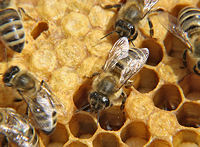Venture Laboratories has been involved in honey testing since our inception. Historically, honey has been used for food and medicinal purposes, and its current applications continue to grow. Therefore, the integrity, composition and overall quality of honey are important to producers, and those who consume, process, and/or use it.
Honey pesticide testing:
When pesticides are used on plants they can be transferred into pollen and nectar. These residues can have dire consequences for honey bee health as well as leading to pesticide contamination of honey products.
Honey pesticide testing services at Venture Laboratories includes the following:
Acetamiprid; Amitraz (DMPF); Azoxystrobin; Bromopropylate; Carbofuran; Carbaryl; Carbendazim; Chlorpyrifos; Clothianidin; Coumaphos; Imidacloprid; Thiamethoxam; Fenpyroximate; Imazalil
Honey antibiotic residue testing:
Antibiotics can be found in honey following bacterial disease treatment of the hive. Antibiotic residues mostly originate from the environmental sources.
Honey antibiotic residue testing services Venture Laboratories provides includes the following:
Sulphadimethoxine; Sulphadiazine; Sulphadoxine; Sulphamethoxazole; Sulphapyridine; Sulphamethoxypyridazine; Sulphachlorpyridazine; Sulphamerazine; Sulphisoxazole; Sulphathiazole; Sulphamethazine; Sulphaquinoxaline; Sulphamonomethoxine; Trimethoprim; Dapsone.
If you don’t see the service you need, contact us.

Acidity:
Acidity is an indication of the degree of honey fermentation, and therefore, honey quality.
Diastase:
Honey diastase activity is a quality factor that is influenced by honey storage and heating; therefore, it is an indicator of honey freshness and overheating.
Microorganisms:
Venture Laboratories offers a full microbiology (click here to go to Microbiology page) laboratory. Total aerobic and anaerobic plate counts, species identification, and Clostridium testing is available. Inquire ( info@ventlabs.com) about other microbiology testing.
Sugar Profile:
Analysis of reducing sugars commonly found in honey, in addition to Glucose, Sucrose, Fructose and Galactose content.
Ash:
Ash content is helpful in depicting floral sources of honey origin.
Hydroxymethylfurfural (HMF):
HMF results from the breakdown of simple sugars (glucose & fructose) at ≤ pH 5. HMF is a naturally-occurring indicator of heat and storage changes in honey, and overall freshness.
Moisture:
Moisture content is the only composition criterion that is part of the Honey Standard that must be fulfilled in the world honey trade. Increased moisture content is an indicator of the ability to undergo fermentation. Honey having high water content is more likely to ferment and therefore decrease honey quality.
Don’t see what you need?
We offer many other assay options or will assist you with method development appropriate to your application.
Catalase:
Catalase is a very important enzyme that is naturally found in honey. It catalyzes the conversion of damaging hydrogen peroxide to water and elemental oxygen.
Invertase:
Invertase is the enzyme responsible for the conversion of sucrose to fructose and glucose. A freshness invertase standard is used in honey standards of the Beekeeper’s Associations of Germany, Belgium and Spain. Invertase is sensitive to heat and storage damage, and therefore is a freshness indicator.
Proline:
Proline content varies among types of honey, and is a criterion for ripeness. In some cases, honey proline content is used as an indicator of sugar adulteration.
Services Provided by Venture Laboratories:
Test |
Method |
| Acidity | AOAC Method for Acidity (Free, Lactone, and Total) of Honey |
| Ash | Ash content for honey |
| Catalase | AOAC and Food Chemicals Codex methods |
| Diastase | AOAC Method for Diastase Activity |
| Hydroxymethylfurfural (HMF) | AOAC Method for Hydroxymethylfurfural in Honey |
| Invertase | AOAC |
| Microorganisms | AOAC and FDA/BAM |
| Moisture | AOAC Method for Moisture in Honey |
| Proline | AOAC Method for Proline in Honey |
| Sugar Profile | AOAC Method for Sugars (Reducing) in Honey and others by AOAC Method for Separation of Sugars in Honey |
